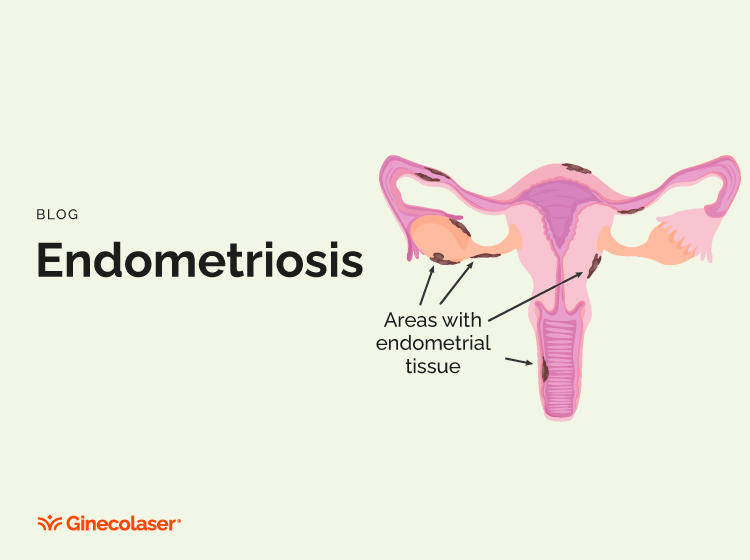Gyne Blog
Endometriosis
Endometriosis is the presence of functional endometrial tissue outside the uterine cavity. It is considered a mysterious and enigmatic disease.

It is often a reason for consultation among the adolescent population as it causes them cyclical or acyclical pelvic pain of varying intensity, sometimes leading to an inability to perform usual activities. In older populations, it also leads to fertility disorders, all of which significantly affect the quality of life of the patients who suffer from it.
It is believed that primary care gynecologists, as well as pediatricians, general practitioners, surgeons, or any specialist treating adolescent patients, should be aware of endometriosis as a potential cause of the symptoms mentioned earlier. The sooner it is diagnosed and treated appropriately, the greater the chances of relieving the pain and preventing possible future consequences on the reproductive health of the affected patients.
Endometriosis is estimated to affect between 10% and 12% of women of reproductive age. Among women consulting for fertility issues, 40% to 50% have endometriosis, and 2% to 3% of postmenopausal patients are affected. It is also present in 47% to 70% of adolescents who do not respond to conventional medical treatment with anti-inflammatory drugs and oral contraceptives for a period of 3 to 6 months.
There has been a relative increase in the percentage of patients suffering from endometriosis. This absolute increase is explained by factors such as delayed first pregnancy, decreased breastfeeding, having fewer children, and exposure to environmental pollutants. These factors lead to more menstrual cycles throughout a woman's life.
Many hypotheses have been proposed to explain why endometriosis occurs. It has been suggested that endometrial tissue might spread through the bloodstream or lymphatic system, or from stem cells in the endometrium that migrate away from the uterus. The most common explanation is retrograde dissemination, where endometrial tissue flows back through the fallopian tubes into the abdominal cavity instead of being expelled during menstruation.
There is a suggested genetic predisposition to developing endometriosis, as the disease often appears more frequently within the same family. There are also inherent factors in each patient that might suggest the appearance of this disease, as well as substances called endocrine disruptors that can alter the patient's endocrine function.
Diagnosis
Endometriosis is a dynamic, progressive disease, and early diagnosis can help prevent impacts on both reproductive health and the psychological and social well-being of the patients who suffer from it.
First, it's important to consider the symptoms. Pain in various forms is the most common symptom and depends on individual sensitivity as well as the sociocultural and familial context of the patient. Adolescents often experience dysmenorrhea (painful menstruation), while adult patients may suffer from chronic pelvic pain and dyspareunia (pain during sexual intercourse), which may or may not be associated with other symptoms.
Dyspareunia is pain during sexual intercourse, and there may be dysuria (pain during urination). Pain can be categorized based on how it presents: it can be cyclical, related to dysmenorrhea or dyspareunia, or non-cyclical, as in chronic pelvic pain. Other less common symptoms include intense fatigue, gastrointestinal disorders, nonspecific abdominal pain, increased rates of allergic conditions, headaches, urinary disorders, low-grade fever, heavy menstrual bleeding, or bleeding outside the menstrual period, among other nonspecific symptoms.
Diagnostic Methods
Non-invasive methods include a thorough medical history, including any family history of the disease, physical examinations, clinical and gynecological evaluations, as well as imaging techniques like gynecological ultrasounds and magnetic resonance imaging (MRI). Laboratory tests like CA 125 and CA 19-9 can be used, although they are sensitive but not very specific, and may be included in the screening process.
Among invasive methods, laparoscopy is the diagnostic method of choice as it allows direct visualization of lesions in the abdominal cavity. These lesions can vary in color depending on their duration: recent lesions are red and active, older lesions are white and are called scar tissue. Laparoscopy allows for biopsy sampling to confirm the diagnosis through pathological examination. Lesions may also appear black or inactive, indicating they are older and less active.
Treatment
The treatment of endometriosis includes surgical and medical approaches, with ovarian suppression being the preferred method. This treatment should be supported by psychosocial support, physical activity, and alternative therapies. The treatment plan depends on the patient's age, the extent of the disease, and the severity of symptoms, including pain and potential impairment of bladder, urethral, or intestinal function. The goal is to improve symptoms such as pain and infertility, enhance overall quality of life, and prevent disease progression and worsening.
Preventive measures for recurrences and focusing on the psychosocial aspect of the patient are also important
